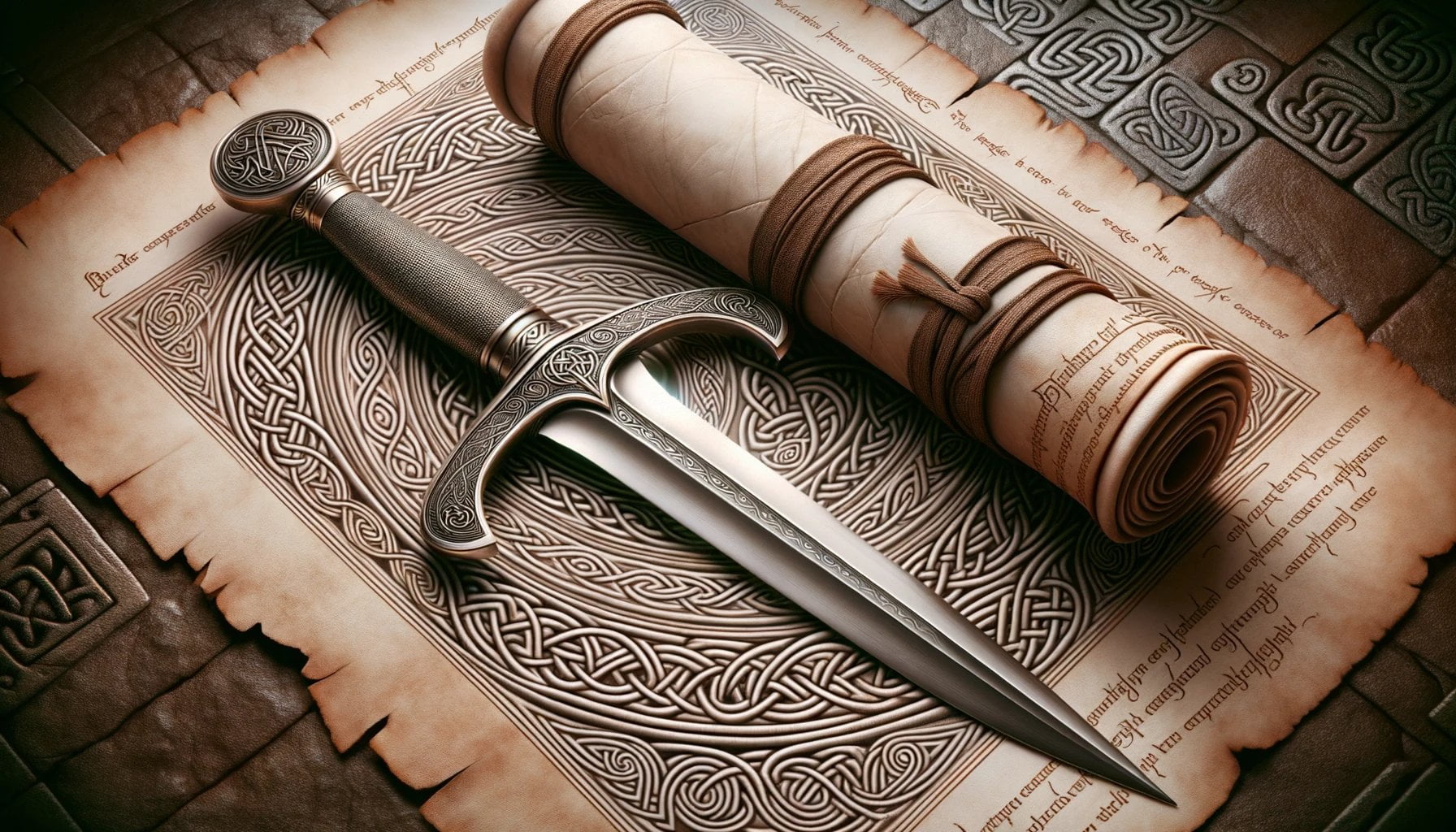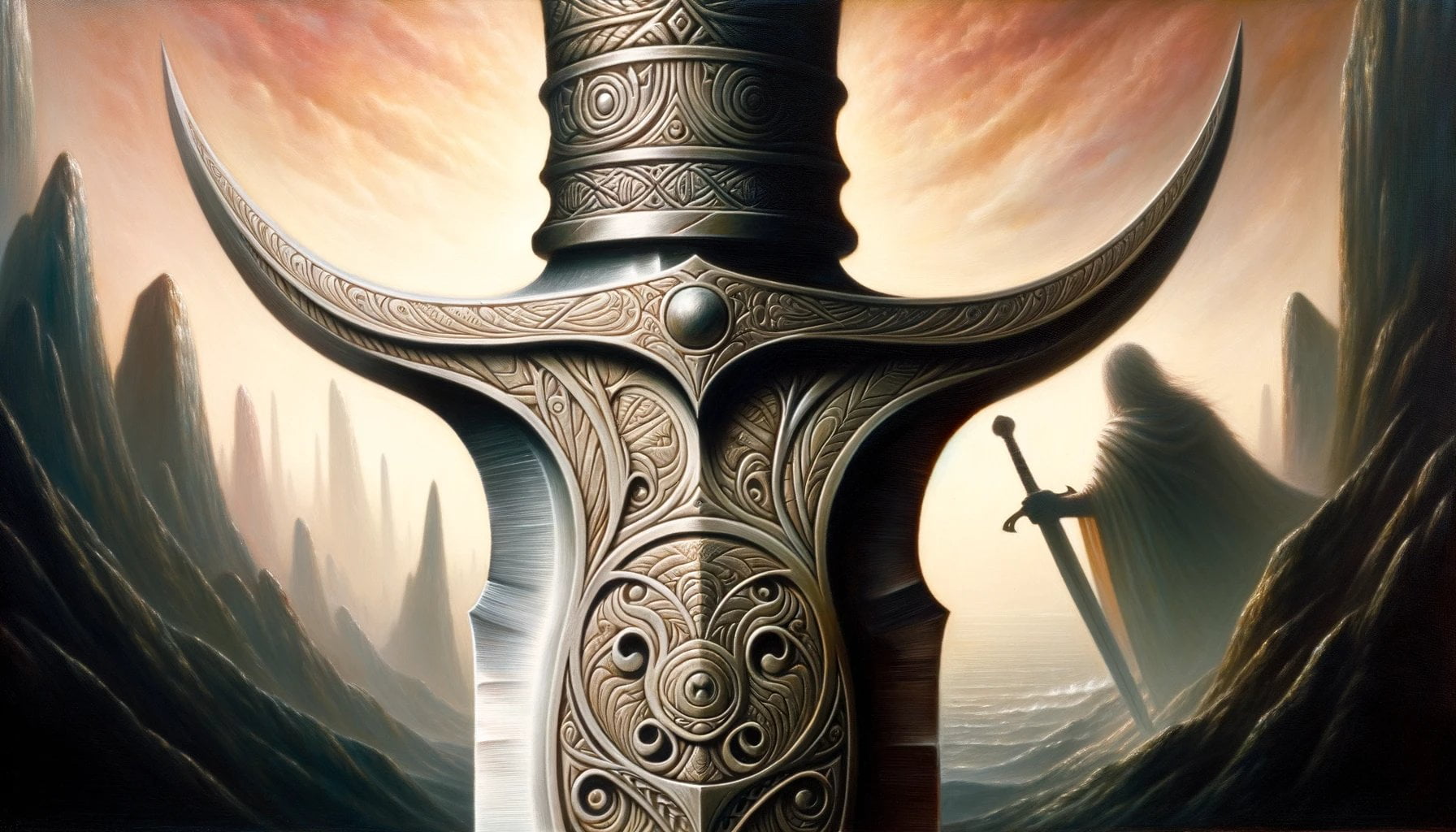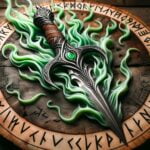Are you an enthusiast of historical armaments, captivated by the allure of ancient weapons? If so, join us on a fascinating journey as we unravel the mysteries surrounding the iconic seax. As an experienced archaeologist, specializing in weapon analysis, I am here to unveil the answer to the burning question: does the seax truly qualify as a dagger? With my expertise and extensive fieldwork, we will delve into the intricate details and evolution of this unique blade, shedding light on its classification within the realm of bladed weapons. Prepare to be captivated by the rich history and secrets hidden within the seax, as we explore its true identity.
Is a Seax a Dagger?

When it comes to the classification of historical weapons, the line between different types can sometimes be blurry. One particular point of contention is whether a seax qualifies as a dagger. Allow me, an experienced archaeologist with a specialization in weapon analysis, to decipher this intriguing question for you.
The Historical Background
First, let’s delve into the historical background of the seax. This weapon, used by the Germanic peoples during the Migration Period and the Early Middle Ages, serves a multifaceted purpose. The word “seax,” derived from Old English, simply means “knife.” However, the seax is not just any knife. It can be considered a small sword, knife, or dagger.
Characteristics and Differences
To better understand the distinction between a seax and a dagger, we must examine their characteristics. Seaxes come in various sizes and designs, including narrow long seaxes, short seaxes, narrow seaxes with engraved designs, light broad seaxes, and heavy broad seaxes. A common feature of a seax is its large, single-edged blade. Additionally, it typically possesses a tang at the centerline of the blade inserted into an organic hilt.
On the other hand, a dagger is generally shorter than a sword and is intended solely for stabbing. While some daggers may share similarities with seaxes, not all daggers are seaxes. The key difference lies in the specific style, construction, and historical usage.
Cultural Significance
The seax holds significant cultural value, particularly for the Germanic peoples it was associated with. In fact, the etymology of the word “seax” suggests that the Saxons named themselves after this very weapon. Seaxes were often found in Anglo-Saxon graves during the seventh century, and later examples are frequently discovered as isolated artifacts.
Apart from its use as a weapon, the seax also played a role in heraldry, appearing as a charge, or symbol, in coats of arms. This further emphasizes its cultural and historical significance.
Addressing Confusion
The confusion regarding the classification of seaxes is understandable given their varied nature. Some may consider them to be daggers, while others argue that they deserve a category of their own. To disambiguate, it’s worth noting that the term “scramaseax” is sometimes used, although it is not attested in Old English and was borrowed from Gregory of Tours’ History of the Franks.
Function and Wear
Seaxes served both as cutting tools and weapons, highlighting their versatility. It is worthwhile to mention that seaxes were worn horizontally inside a scabbard attached to the belt, with the blade’s edge positioned upwards. This ensures easy access and quick deployment when needed.
A Dagger by Any Other Name
In conclusion, while a seax can indeed be classified as a type of dagger, it is essential to recognize that not all daggers are seaxes. The seax is a distinct weapon with unique characteristics and cultural significance. So, the next time you come across the question “Is a seax a dagger?” remember that it’s not a simple yes or no answer but a nuanced exploration of history and weapon classification.
Incorporating my expertise and experience as an archaeologist specializing in weapon analysis, I hope this article has shed some light on the intriguing world of the seax and its relationship to daggers.
Ancient daggers have always captivated historians and enthusiasts alike. If you’re interested in learning more about these fascinating weapons, click here to explore our collection of ancient daggers.
Defining Features of a Dagger
The world of historical armaments can be fascinating and complex, with various types of weapons that have evolved over the centuries. One such weapon that raises questions is the seax. While it is commonly referred to as a dagger, its classification can be a source of confusion for enthusiasts and scholars alike. So, what are the defining features of a dagger, and does the seax truly qualify as one? Let’s delve into this topic and explore the distinct characteristics that define a dagger.
What Sets a Dagger Apart?
Daggers, by definition, are bladed weapons that are shorter than swords and specifically designed for stabbing. They have a long and rich history, serving both practical and ceremonial purposes throughout different cultures and time periods. Now let’s examine some key features that distinguish daggers from other bladed weapons.
- Size and Shape: Daggers are typically smaller than swords, with a blade length that varies but generally falls within a certain range. They often have a sharply pointed tip, which enhances their stabbing capabilities.
- Blade Configuration: Daggers are characterized by their double-edged blades, meaning they have two sharpened edges that run along both sides of the blade. This feature facilitates versatility in combat scenarios.
- Intended Use: Unlike swords, which are capable of both slashing and stabbing, daggers are primarily intended for quick, precise stabbing motions. Their compact nature allows for ease of concealment and swift deployment, making them a favored weapon for close-quarters combat.
Deciphering the Seax
Now that we have a clear understanding of what defines a dagger, let’s explore the seax and determine if it fits within this classification. The seax is a type of dagger that was used by the Saxons during the Migration Period and the Early Middle Ages. It derived its name from the Old English word for “knife” and played a significant role in Saxon culture and warfare. But does it meet the defining features of a dagger?
- Size and Shape: Seaxes are generally larger than average daggers, sometimes even approaching the length of a shortsword. Their blades are long and single-edged, tapering to a point. While they exceed the typical size range of a dagger, this does not disqualify them from being considered as such.
- Blade Configuration: Seaxes have a single sharp edge, unlike the double-edged blades that define daggers. This variation in the blade configuration distinguishes them from traditional daggers, making them more akin to a single-edged sword or knife.
- Usage and Cultural Significance: Seaxes served as both cutting tools and weapons, encompassing a broader scope of utility compared to traditional daggers. They were worn horizontally on the belt for easy access and played a prominent role in Saxon society, often appearing as symbols in heraldry. The cultural significance and varied uses of the seax highlight its distinction from conventional daggers.
The Verdict
In light of these observations, it becomes clear that while all seaxes can be classified as daggers due to their single sharp edge, not all daggers can be considered seaxes. The seax possesses distinct characteristics that set it apart from conventional daggers, such as its larger size, single-edged blade, and broader range of uses. Thus, we can conclude that the seax, while belonging to the broader category of daggers, cannot be solely defined as such.
In the realm of historical armaments, the classification of weapons can be blurry, with overlapping features and varied interpretations. It is essential to consider the historical context, cultural significance, and unique characteristics of each weapon to truly understand its nature. The seax stands as a testament to the intricacies of weapon classification, reminding us that the evolution and diversity of armaments contribute to the richness of our historical legacy.
Comparing the Seax and Dagger
The world of historical armaments is a fascinating one, filled with intricate details and subtle nuances. As an experienced archaeologist specializing in weapon analysis, I have spent years studying the evolution and classification of bladed weapons. Today, we embark on a quest to decipher one such enigma: the seax. The question at hand is whether a seax truly qualifies as a dagger, and we will explore the comparisons between these two weapons to find the answer.
To begin our exploration, let’s define the features that distinguish a dagger. A dagger typically possesses a single cutting edge, a whittle or rat-tail tang, and is often devoid of a bolster or pommel. The blade itself is worn horizontally inside a scabbard attached to the belt, with the edge facing upwards. Daggers are designed for stabbing and have a large single-edged blade.
Now, let’s turn our attention to the seax. A seax is a type of dagger that was commonly carried by Germanic peoples during the Migration Period and the Early Middle Ages. The attack with a seax is made with the side of its wide blade, rather than the point. The name “seax” itself translates to “knife” in Old English, and it is believed that the Saxons derived their name as a people from this weapon. Seaxes vary in size, but they all possess a single blade that tapers to a point.
Seaxes were often worn in combination with double-edged swords and served as sidearms. They held cultural significance, featuring prominently in Anglo-Saxon graves and even playing a role in heraldry. The term “scramaseax” is sometimes used to distinguish seaxes from other types of daggers.
In popular culture, we see a reference to seaxes in the game Assassin’s Creed Valhalla, where they are mentioned as a type of dagger. Intriguingly, there is even a perk to increase mastery with seaxes, highlighting their distinction and importance in historical contexts.
Now that we have established the characteristics of both daggers and seaxes, we can address the question of their classification. While daggers are generally shorter than swords and designed solely for stabbing, seaxes exhibit distinct differences. Seaxes are larger than average daggers, with single-edged blades that are used for cutting and slashing rather than solely stabbing. They are versatile weapons that served both as tools and instruments of combat.
Although seaxes possess the key features of a dagger, not all daggers can be classified as seaxes. It is essential to understand the historical context, cultural significance, and unique characteristics of each weapon to determine their classification accurately.
To consider the seax merely as a dagger would be to overlook its complexity and the rich historical legacy behind it. Delving into the nuances of weapon classification demonstrates the intricacies inherent in understanding our past. It is this passion for historical analysis and the desire to uncover the truth that drives archaeologists like me to explore the fascinating world of weapons.
In conclusion, a seax can indeed be considered a type of dagger, but not all daggers can be classified as seaxes. The seax possesses its own distinct qualities and cultural significance, leaving a lasting impact on history. By comparing and understanding the similarities and differences between these two weapons, we gain a deeper appreciation for the complexities of weapon classification and the significance of the seax in our historical legacy.
In the end, it is the unwavering dedication of passionate archaeologists and researchers that allows us to unlock the secrets of our past, piecing together the complex puzzle of weapon evolution and classification.
Buckle up, fellow history enthusiasts, and embark on this journey alongside me as we gaze into the shadows of history, deciphering the fascinating realm of the seax and its parallel with the dagger.
Understanding the Distinctions and Debates
The world of historical armaments is a fascinating realm, filled with intricate details and nuanced differences between weapons. One such topic of discussion revolves around the classification of the seax. Is it truly a dagger, or does it possess distinct qualities that set it apart? Join us on this journey as we delve into the seax and unravel the complexities of its classification.
Origins and Characteristics
The seax is an ancient weapon with a rich history. Its name derives from the Old English word for “knife,” which already hints at its versatile nature. While seaxes were commonly used by Germanic peoples during the Migration Period and the Early Middle Ages, their purpose extended beyond combat. These multipurpose tools served hunters, played a role in dressing animals, and were handy for cutting ropes.
What sets the seax apart from other blades is its long, side-edged blade. This blade design distinguishes the seax from other daggers, such as the scramasax. The term “seax” specifically refers to Viking or Anglo-Saxon knives with this particular characteristic. However, seaxes come in various sizes, with some blurring the line between being a knife and a shortsword.
Debunking the Dagger Conundrum
There is some confusion surrounding the classification of seaxes, often referred to as daggers. While seaxes share similarities with daggers, not all daggers can be considered seaxes. Daggers are generally shorter than swords and primarily designed for stabbing. On the other hand, seaxes excel at cutting and slashing, making them a versatile weapon in close combat situations.
To better understand the distinctions, it is crucial to consider the key features of daggers. Size and shape, blade configuration, and intended use all play significant roles in differentiating daggers from other bladed weapons. Daggers typically have a single cutting edge, a whittle or rat-tail tang, and are often without a bolster or pommel. Their design allows for easy concealment and swift one-handed deployment.
On the other hand, the seax boasts a single, side-edged blade that tapers to a point. Its wider blade provides additional cutting power, enabling it to excel in slashing actions. Seaxes were worn horizontally on the belt for easy access, often complementing double-edged swords. Their size, organic hilt, and strong cultural significance make them more than just a dagger.
The Cultural Significance
Seaxes held great cultural significance, particularly among the Saxons, to the extent that they potentially named themselves after the weapon. These blades were not merely tools or weapons but also played a role in heraldry. Their presence in Anglo-Saxon graves further underscores their importance in society. Uncovering their secrets adds depth to our understanding of history and the evolution of weapons.
Conclusion
In exploring the topic of whether a seax qualifies as a dagger, we have unraveled its unique characteristics and cultural significance. While a seax can be classified as a type of dagger, it possesses distinct qualities that set it apart. The seax’s long, side-edged blade and versatile nature make it a formidable weapon, extending beyond the conventional confines of a dagger’s design. By understanding the distinctions and debates surrounding the seax, we gain valuable insights into the intriguing world of historical armaments.

FAQ
Q1: What is the purpose of a Seax?
A1: The purpose of a Seax is versatile, as it was used for hunting, dressing animals, cutting ropes, and close combat fighting.
Q2: How does the size of Seax knives vary?
A2: Seax knives vary in size, with some being long enough to be called shortswords.
Q3: Is a Seax considered a dagger?
A3: There is some confusion regarding the classification of seaxes, as they are sometimes referred to as daggers.
Q4: What is the origin of the word “seax”?
A4: The word “seax” comes from the Old English word for “knife.”
Q5: What is the distinguishing feature of a Seax?
A5: Seaxes have a long, side-edged blade.
- Unveiling Bernhard Caesar Einstein’s Scientific Achievements: A Legacy in Engineering - July 15, 2025
- Uncover who is Jerry McSorley: CEO, Family Man, Business Success Story - July 15, 2025
- Discover Bernhard Caesar Einstein’s Scientific Contributions: Unveiling a Legacy Beyond Einstein - July 15, 2025















